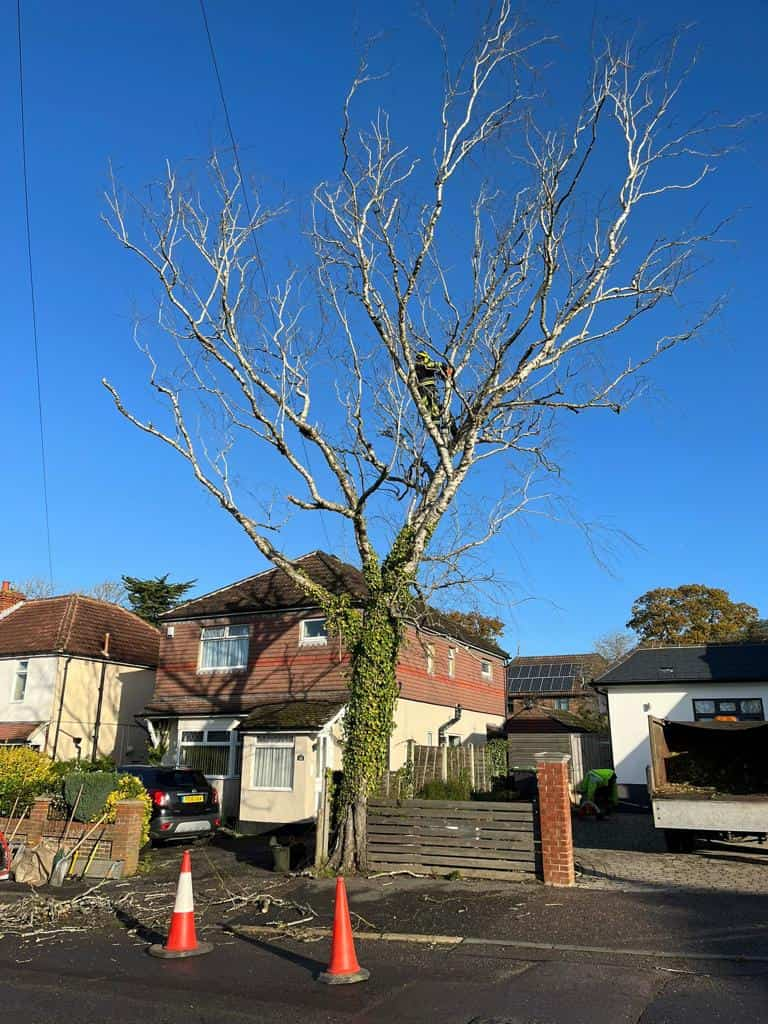Tree felling is often seen as a last resort when dealing with diseased or dying trees. However, there are instances where seemingly healthy trees must be removed for safety, environmental, or structural reasons. Property owners in Emsworth, Hampshire, may wonder why a tree that appears robust could still pose risks that warrant removal. Understanding the key factors behind tree felling decisions can help in making informed choices about tree management.
Hidden Risks Beneath a Healthy Exterior
1. Structural Instability
A tree may appear healthy on the outside while suffering from internal weakness. Issues such as decay, poor root anchorage, or internal cavities can compromise structural integrity, increasing the risk of collapse. Warning signs include:
- Hollow or soft spots in the trunk.
- Fungal growth at the base, indicating internal rot.
- Leaning or sudden shifts in position after heavy rainfall.
Even if a tree seems fine at first glance, a professional assessment may reveal underlying weaknesses that necessitate removal.
2. Root Damage and Instability
Tree roots provide essential support and nutrient absorption, but they can be damaged by:
- Construction work and soil compaction.
- Flooding or drought conditions.
- Fungal infections such as honey fungus, which attacks the root system.
Once a tree loses root stability, it may become a hazard, particularly in strong winds. A tree with compromised roots may not show obvious signs of distress but can still be at risk of sudden failure.
Environmental and Safety Concerns
3. Trees Growing Too Close to Buildings
Large trees situated too close to homes, garages, or commercial structures can cause significant damage over time. Potential risks include:
- Cracks in foundations due to root growth.
- Roof and gutter damage from overhanging branches.
- Increased moisture retention near walls, leading to damp problems.
Felling may be necessary if pruning alone is insufficient to mitigate these risks.
4. Interference with Power Lines and Infrastructure
Trees near overhead power lines or underground utilities can create serious hazards. While trimming may provide a temporary solution, repeated pruning can weaken the tree over time, making removal the safest long-term option.
5. Encroachment on Other Trees or Green Spaces
In some cases, tree removal is needed to protect the health of surrounding vegetation. Trees competing for limited light, water, and soil nutrients can hinder the growth of nearby plants. Removing an overcrowded or poorly positioned tree allows the remaining landscape to thrive.
Disease and Pest Infestation
6. Hidden Diseases
Even if a tree appears healthy, certain diseases can spread internally before visible symptoms emerge. Some fungal infections cause internal decay while leaving the exterior looking intact. Common threats include:
- Dutch Elm Disease – Spreads through root systems and can be fatal.
- Ash Dieback – Weakens trees structurally, making them prone to breakage.
- Honey Fungus – Attacks tree roots, often going unnoticed until the tree collapses.
An infected tree may not yet show signs of distress, but proactive removal can prevent the spread of disease to other trees in the area.
7. Pest Infestations
Certain insect infestations weaken trees from within, leading to instability. While some infestations can be treated, others may cause irreversible damage that requires removal to prevent further spread. Common pests include:
- Wood-boring beetles.
- Asian longhorn beetles.
- Oak processionary moths.
Legal and Planning Considerations
8. Planning Permissions and Development Projects
Sometimes, healthy trees must be removed to accommodate construction or land development projects. Even in such cases, professional consultation ensures compliance with local tree protection laws and environmental guidelines.
9. Risk to Public Safety
Public parks, walkways, and roadside trees are regularly inspected to identify potential hazards. If a tree poses a risk to pedestrians, vehicles, or nearby properties, authorities may require its removal—even if it appears healthy.
The Importance of Professional Assessment
Tree felling should never be undertaken without expert consultation. A professional tree surgeon can:
- Conduct a thorough assessment to determine if removal is necessary.
- Explore alternative solutions such as bracing, pruning, or cabling.
- Ensure compliance with conservation laws and Tree Preservation Orders (TPOs).
Conclusion
A tree that looks healthy to the untrained eye may still pose risks that warrant removal. Structural instability, hidden disease, root damage, and encroachment issues are just some of the reasons why felling may be the safest course of action. For homeowners and businesses in Emsworth, Hampshire, seeking professional guidance ensures that trees are managed responsibly, maintaining both safety and environmental balance.
If you suspect a tree on your property may require removal, consulting an experienced tree surgeon is the best way to assess the risks and determine the most appropriate action.
Call us on: 01243 979 695
Click here to find out more about LM Tree Surgery Emsworth
Click here to complete our contact form and see how we can help with your tree needs.

